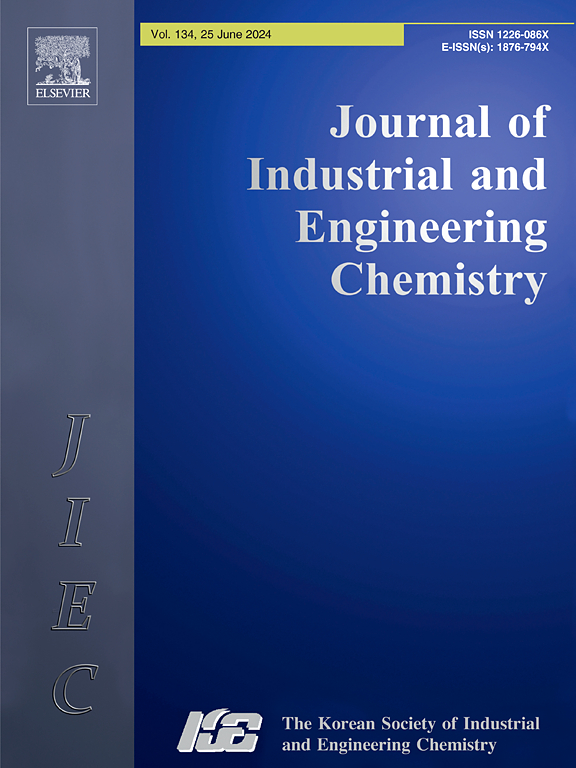Synthesis of activated N/O/S-codoped porous carbon from waste sugarcane bagasse cellulose for high energy density solid-state asymmetric supercapacitors
IF 5.9
3区 工程技术
Q1 CHEMISTRY, MULTIDISCIPLINARY
Journal of Industrial and Engineering Chemistry
Pub Date : 2025-04-04
DOI:10.1016/j.jiec.2025.04.004
引用次数: 0
Abstract
Carbon materials (CMs) derived from waste biomass have unique porous structures, excellent electrical conductivity, and superior chemical stability, making them ideal as energy storage materials. However, biomass-derived carbon materials have yet to achieve high energy density. These CMs could be improved by heteroatom doping. In this study, nitrogen, oxygen, and sulfur co-doped activated porous carbon (NOS-WSBC) was synthesized via carbonization of L-cysteine modified waste sugarcane bagasse cellulose followed by KOH/CO2 activation of doped carbon. L-cysteine concentration was varied to optimize textural and electrochemical properties of NOS-WSBC. As optimized NOS-WSBC 0.5 possesses a superior specific surface area of 1914.76 m2/g and mesopore volume of 0.1138 cm3/g, together with a bulk density of 1.18 g/cm3 and total heteroatom content of 16.25 atom%. Because of these unique features, the NOS-WSBC 0.5 delivered a high gravimetric specific capacitance of 462.3F/g and a volumetric specific capacitance of 542.8F/cm3 at 0.2 A/g in 6 M KOH. A solid-state asymmetric supercapacitor (ASC) device was assembled with WSBC and NOS-WSBC 0.5 electrodes, using KOH loaded PVA/PEG/SiO2 membrane electrolyte. The ASC delivered a high energy density of 70.47 Wh kg−1 at a power density of 200 W kg−1 and excellent capacitance retention of 97.7 % after 10,000 cycles.

用废蔗渣纤维素合成活性N/O/ s共掺杂多孔碳用于高能量密度固态不对称超级电容器
来源于废弃生物质的碳材料(CMs)具有独特的多孔结构、优异的导电性和优异的化学稳定性,是理想的储能材料。然而,生物质衍生的碳材料尚未达到高能量密度。杂原子掺杂可以改善这些CMs。本研究以l -半胱氨酸修饰的废甘蔗渣纤维素为原料,经KOH/CO2活化后碳化,合成了氮、氧、硫共掺杂的多孔活性炭(NOS-WSBC)。通过改变l -半胱氨酸浓度来优化NOS-WSBC的结构和电化学性能。优化后的NOS-WSBC 0.5具有优异的比表面积1914.76 m2/g,介孔体积0.1138 cm3/g,堆积密度1.18 g/cm3,总杂原子含量16.25原子%。由于这些独特的特性,NOS-WSBC 0.5在0.2 a /g和6 M KOH条件下提供了462.3F/g的高重量比电容和542.8F/cm3的体积比电容。采用KOH负载PVA/PEG/SiO2膜电解质,用WSBC和NOS-WSBC 0.5电极组装固态非对称超级电容器(ASC)器件。在200 W kg - 1的功率密度下,ASC提供了70.47 Wh kg - 1的高能量密度,并且在10,000次循环后电容保持率为97.7%。
本文章由计算机程序翻译,如有差异,请以英文原文为准。
求助全文
约1分钟内获得全文
求助全文
来源期刊
CiteScore
10.40
自引率
6.60%
发文量
639
审稿时长
29 days
期刊介绍:
Journal of Industrial and Engineering Chemistry is published monthly in English by the Korean Society of Industrial and Engineering Chemistry. JIEC brings together multidisciplinary interests in one journal and is to disseminate information on all aspects of research and development in industrial and engineering chemistry. Contributions in the form of research articles, short communications, notes and reviews are considered for publication. The editors welcome original contributions that have not been and are not to be published elsewhere. Instruction to authors and a manuscript submissions form are printed at the end of each issue. Bulk reprints of individual articles can be ordered. This publication is partially supported by Korea Research Foundation and the Korean Federation of Science and Technology Societies.

 求助内容:
求助内容: 应助结果提醒方式:
应助结果提醒方式:


